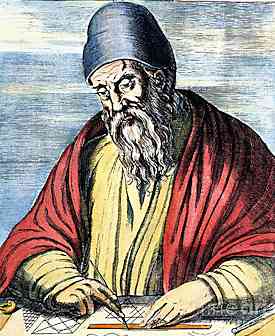Euclid
Sometimes called Euclid of Alexandria, Euclid was a Greek mathematician
that is usually referred to as the Father of Geometry. He authored
Elements which is one of the most influential works in the history
of mathematics.
|
|
 Euclid
Euclid |
From the time it was published until the early 20th century,
it served as the main textbook for teaching mathematics particularly
geometry. It is in this mathematical and geometric treatise that
Euclid deduced the principles of Euclidean geometry and wrote
about conic sections, geometry, number theory, rigor and perspective.
Euclid short bio and contributions to science
- Euclid in Greek means "good glory", the anglicized
version of the Greek name also means "renowned or glorious".
As the greatest geometrician that ever lived, he was definitely
aptly named.
- He was presumed a prodigy of the famous philosopher and scholar
Plato, and was active during the reign of Ptolemy 1 in Alexandria,
which is around 323 to 283 BC.
- Not much is known about the life of Euclid because of the
lack of original references. He was rarely mentioned by other
Greek mathematicians, and the few historical references to him
were only written centuries after he lived. The date, place
and circumstances surrounding his birth and death are unknown.
Some researchers even proposed that Euclid does not refer to
one person, but a team of mathematicians that called themselves
Euclid. This theory, however, is not widely accepted.
- No one really knows what Euclid looks like, although many
famous artists tried to paint his portrait. So, whatever pictures
of Euclid that exist today can be credited to the artists' imagination.
- Euclid wanted to prove the truth about things using logic
and reason. His books begin with the basic definitions of line
shapes and a point, and then move on to more complicated aspects
in geometry. She proved that all right angles are equal and
that a straight line can be drawn between any two points. He
also wrote advanced math the tackles irrational numbers three-dimensional
geometry triangles and circles.
- His books are known all over the world as easy to understand,
which is why they are widely used as the main math book in America,
Europe and West Asia until the turn of the 20th century. Mathematicians
today still begin studying geometry using Euclid's books.
- He was widely known for his second theorem on prime numbers.
This is where he proved in a clear and concise manner that the
number of prime numbers is infinite. To this day mathematicians
are still trying to prove the theory wrong.
- Elements consist of 13 books that exhaustively dealt with
ratios and proportions, spatial geometry and plane geometry.
It contains a collection of postulates (axioms), definitions,
mathematical proofs of the propositions, and propositions (theorems
and constructions). Books 1 to 4 tackled Plane Geometry, Books
5 to 10 introduced ratios and proportions, and Books 11 to 13
discussed Spatial Geometry.
- Compared to mathematicians and geometricians that come before
and after Euclid, he was the only one who possessed the logic,
precision and ability to derive perfect conclusions using systematic
proofs. This is why Euclid's Elements remains an indisputable
and unchallenged standard text. It may no longer be widely used
today, but a lot of mathematicians still use Elements to learn
about geometry.
If there is one thing that is known about Euclid is that he was
unquestionably the greatest Geometrician that ever lived.
Rumor Has It …
… that even though Euclid was considered a square in his day,
he also had a well-rounded education.
Written by Kevin Lepton
Published June 21, 2015
|

